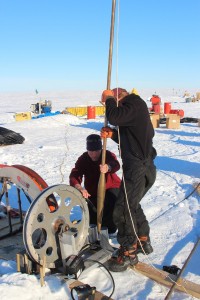Warming ocean thawing Antarctic glacier, researchers say
September 18, 2013

Diana Campbell
907-474-5229
9/18/13
For the first time, researchers completed an extensive exploration of how quickly ice is melting underneath a rapidly changing Antarctic glacier, possibly the biggest source of uncertainty in global sea level projections.
Martin Truffer, a physics professor at the University of Alaska Fairbanks, and Tim Stanton, an oceanographer with the Naval Postgraduate School, were able to look underneath the Pine Island Glacier on the West Antarctic Ice Sheet and take exact measurements of the undersea melting process.
“This particular site is crucial, because the bottom of the ice in that sector of Antarctica is grounded well below sea level and is particularly vulnerable to melt from the ocean and break up,” said Truffer, a researcher with UAF’s Geophysical Institute. “I think it is fair to say that the largest potential sea level rise signal in the next century is going to come from this area.”
Their measurements show that, at some locations, warm ocean water is eating away at the underside of the ice shelf at more than two inches per day. This leads to a thinning of the ice shelf and the eventual production of huge icebergs, one of which just separated from the ice shelf a few months ago.

“UAF’s part was to accomplish the drilling,” Truffer said, crediting Dale Pomraning, with the GI’s machine shop.
“We have a hot water drill that is modular enough to be deployed by relatively small airplanes and helicopters, and we have the expertise to carry this out.”
The drilling allowed the team to measure an undersea current of warm water, driven by fresh water from the melting glacier. The measurements will be used with both physical and computer models of ocean and glacier systems, said Stanton.

ADDITIONAL CONTACTS: Martin Truffer, email: truffer@gi.alaska.edu; Amy Hartley, phone: 907-474-5823 or amy.hartley@gi.alaska.edu. Naval Post Graduate School: Lt. Cmdr. Bill Clinton, 831-656-3567 or whclinto@nps.edu.
NOTE TO EDITORS: Truffer is away from the office, but is available via email.
ON THE WEB:
UAF Geophysical Institute: http://gi.alaska.edu
Science: http://bit.ly/1eXCZoV
NPS: http://bit.ly/17HE5kB
DC/9-18-13/056-14


